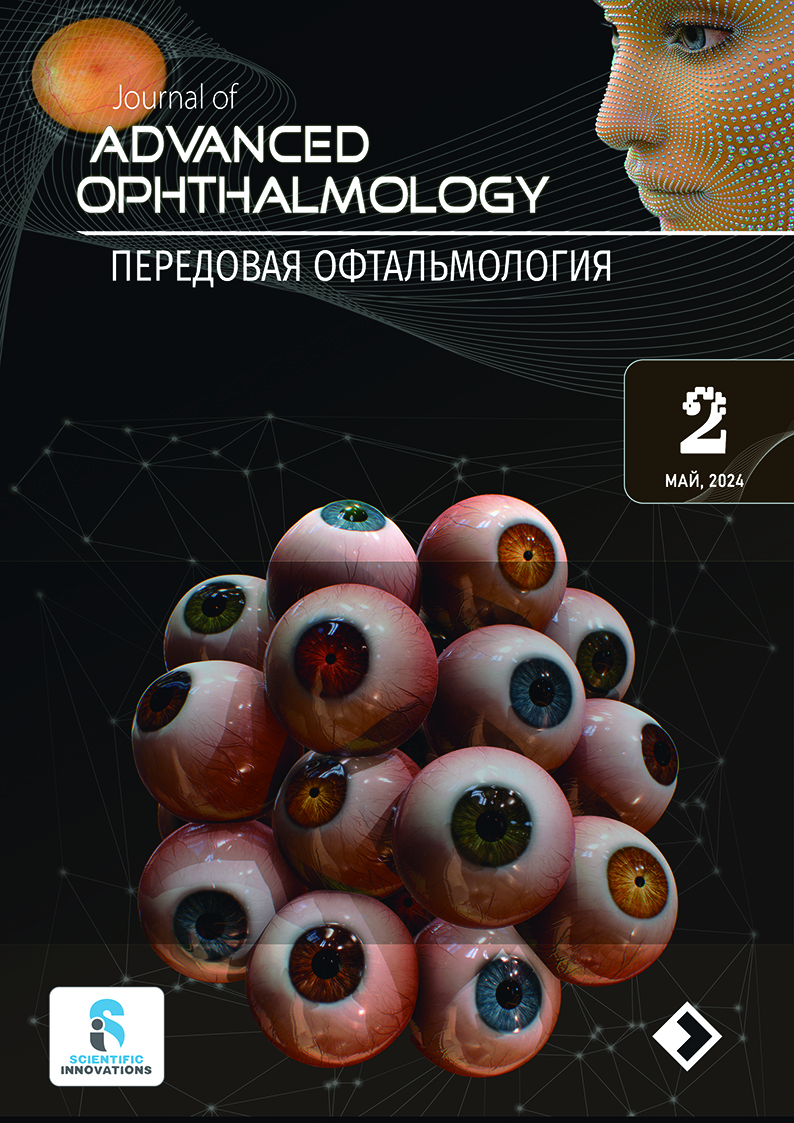CLINICAL EXPERIENCE OF MIXED ASTIGMATISM AND ANISOMETROPIC AMBLYOPIA CORRECTION IN ADOLESCENTS USING FEMTOLASIK TECHNOLOGY
DOI:
https://doi.org/10.57231/j.ao.2024.8.2.026Keywords:
femtoLASIK, adolescents, mixed astigmatism, refractive amblyopiaAbstract
Relevance. Refractive amblyopia against the background of anisometropic refraction, especially with mixed astigmatism, does not respond well to conservative treatment, is accompanied by a disorder of binocular functions and is one of the causes of visual disability. Purpose of the study. To evaluate the effectiveness and safety of excimer laser vision correction using the femtoLASIK method in adolescents with mixed astigmatism and anisometropic amblyopia. Materials and methods. The study group included 20 patients (20 eyes) aged from 14 to 17 years (average 13.8±0.85 years) with mixed astigmatism from 3.25 to 5.5 diopters. During surgery and in the postoperative period, no complications were noted in any case. Results and conclusion. As a result of laser correction, the following refractive indices were achieved in patients: a decrease in the amount of astigmatism by 4.21±0.44 diopters. (88.1% of the original value) and the value of anisometropia – 4.1±0.53 diopters. (90.1% of the original value). Conclusions. The effectiveness and safety of laser correction determines its priority in the complex treatment of refractive and anisometropic amblyopia in children and adolescents with mixed astigmatism. Reducing the degree of amblyopia and the magnitude of anisometropia using the femtoLASIK method improves the quality of vision and ensures optimal social adaptation of children and adolescents.
References
Аветисов С.Э. Современные подходы к коррекции рефракционных нарушений // Вестник. офтальмологии. – 2006. – № 1. – С. 3 - 8. [Avetisov S.E. Modern approaches to the correction of refractive errors // Bulletin. ophthalmology.–2006.–No.1.–P.3-8.(In Russ.] DOI: http://doi.org/10.31288/oftalmolzh201935758
Ермилова И.С. Система реабилитации детей со сложными видами аномалий рефракции на базе хирургических методов: Дис.... д-ра мед. наук. – М., 1999. – 271 с. [Yermilova I.S. Sistema reabilitatsii detey so slojnimi vidami anomaliy refraktsii na baze xirurgicheskix metodov [Dissertation] 2000 (In Russ.]
Костюченкова Н.В. Аберрации оптической системы глаза при различных методах коррекции астигматизма у детей и подростков: Автореф. дис. канд. мед. наук.– М., 2008. – 26 с. [Kostyuchenkova N.V. Aberratsii opticheskoy sistemi glaza pri razlichnix metodax korrektsii astigmatizma u detey i podrostkov [Dissertation] 2008 (In Russ.]
Назарова Г.А. Эффективность восстановительного лечения пациентов с рефракционной и анизометропической амблиопией после фоторефракционных операций. – Автореф. дисс. ... канд. мед. наук. – Москва. – 2007. – С.109. [Nazarova G.A. Effektivnost vosstanovitelnogo lecheniya patsientov s refraktsionnoy I anizometropicheskoy ambliopiey posle fotorefraktsionnix operatsiy [Dissertation] 2007 (In Russ.]
Розенблюм Ю.З. Функционально-возрастной подход к компенсации аметропий // Вестн. офтальмологии. – 2004. – № 1. – С. 51 - 56. [Tarutta E.P. Strategically oriented correction of mixed astigmatism in children. Russian Ophthalmological Journal. 2023;16(2):92-98. (In Russ.)] DOI: https://doi.org/10.21516/2072-0076-2023-16-2-92-98
Alio J.L., Wolter N.V., Pinero D.P. et al. Pediatric refractive surgery and its role in the treatment of amblyopia: meta – analysis of the peer – reviewed literature // J.Refract.Surg.–2011.–Vol.27.–№5.–P.364-374.DOI:https://doi.org/10.3928/1081597X-20100831-01
Drack A.V., Nucci P. Refractive surgery in children. Ophthalmol Clin North Am.2001;14(3):457–66. DOI: https://doi.org/10.1016/S0896-1549(05)70244-3
France L.W. Evidence-based guidelines for amblyogenic risk factors. // Am. Orthopt. J. – 2006. – Vol.56. – P. 7 - 14. DOI: https://doi.org10.3368/aoj.56.1.7
Elitcroft D.I., Adams G.G. et al. Retinal dysfunction and refractive errors: an electrophysiological study of children // Br. J. Ophthalmol. – 2005. – Vol. 89. – No. 4. – P. 484 - 488. DOI: https://doi.org/10.1136/bjo.2004.045328
Morad Y, Bakshi E, Levin A, Binyamini OG, Zadok D, Avni I, Dayan YB. Screening and treating amblyopia: are we making a difference? // Invest Ophthalmol Vis Sci. – 2007. – Vol. 48. – No. 5. – P. 2084 - 2088. DOI: https://doi.org/10.1167/iovs.06-0089
Paysse E.A., Tychsen L., Stahl E. Pediatric refractive surgery: corneal and intraocular techniques and beyond. J AAPOS. 2012; 16(3):291–7. DOI: https://doi.org/10.1016/j.jaapos.2012.01.012
Pausse E. Refractive surgery in children:is it ready for prime time? Am. J. Ophthalmol. 2007;57:79–88. DOI: https://doi.org/10.3368/aoj.57.1.79
Simons K. Amblyopia characterization, treatment, and prophylaxis. Surv.Ophthalmol. 2005;50(2):123–66. DOI:https://doi.org/10.1016/j.survophthal.2004.12.005
Yin Z. Q., Wang H. Facilitation of amblyopia managment by laser in situ keratomileusis in high anisometropic hyperopic and myopic children. // J. AAPOS. –2007.–Vol.11.–No.6.–P.571-576.DOI: https://doi.org/10.1016/j.jaapos.2007.04.014
Yangieva N.R., Tuychibaeva S.S., Agzamova S.S. Current state of the issue on the problem of morbidity and disability in ophthalmopathology. Advanced ophthalmology. 2023; 5(5): 77-83. DOI: https://doi.org/10.57231/j.ao.2023.5.5.014
Weakley D.R. Jr. The association between nonstrabismic anisometropia, amblyopia, and subnormal binocularity. // Ophthalmology. – 2001. – Vol. 108. – P. 163 - 171. DOI: https://doi.org/10.1016/S0161-6420(00)00425-5
Downloads
Published
Issue
Section
License
Copyright (c) 2024 Бахритдинова Ф.А., Назирова С.Х., Миррахимова С.Ш., Хаджимухамедов Б.Б.

This work is licensed under a Creative Commons Attribution-NonCommercial-NoDerivatives 4.0 International License.

